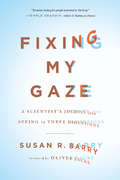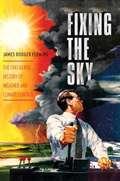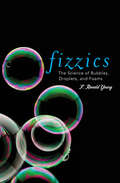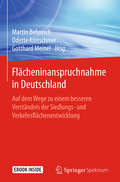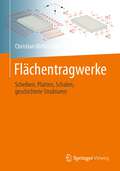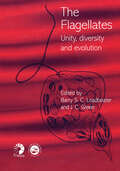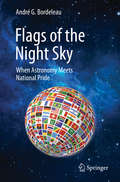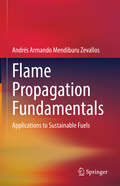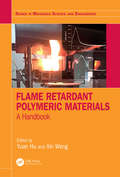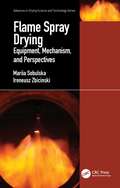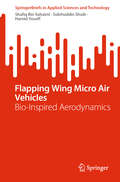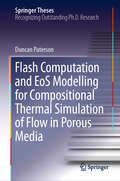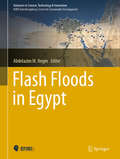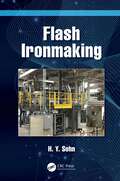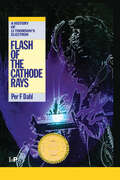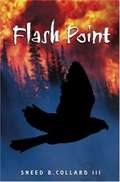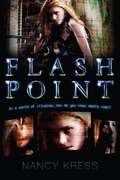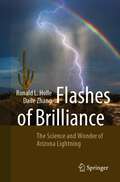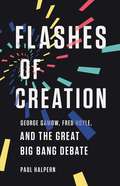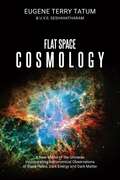- Table View
- List View
Fixing My Gaze $ A Scientist's Journey Into Seeing in Three Dimensions: A Scientist's Journey Into Seeing in Three Dimensions
by Susan R. BarryWhen neuroscientist Susan Barry was fifty years old, she took an unforgettable trip to Manhattan. As she emerged from the dim light of the subway into the sunshine, she saw a view of the city that she had witnessed many times in the past but now saw in an astonishingly new way. Skyscrapers on street corners appeared to loom out toward her like the bows of giant ships. Tree branches projected upward and outward, enclosing and commanding palpable volumes of space. Leaves created intricate mosaics in 3D. With each glance, she experienced the deliriously novel sense of immersion in a three dimensional world. Barry had been cross-eyed and stereoblind since early infancy. After half a century of perceiving her surroundings as flat and compressed, on that day she was seeing Manhattan in stereo depth for first time in her life. As a neuroscientist, she understood just how extraordinary this transformation was, not only for herself but for the scientific understanding of the human brain. Scientists have long believed that the brain is malleable only during a “critical period” in early childhood. According to this theory, Barry’s brain had organized itself when she was a baby to avoid double vision – and there was no way to rewire it as an adult. But Barry found an optometrist who prescribed a little-known program of vision therapy; after intensive training, Barry was ultimately able to accomplish what other scientists and even she herself had once considered impossible. A revelatory account of the brain’s capacity for change, Fixing My Gaze describes Barry’s remarkable journey and celebrates the joyous pleasure of our senses.
Fixing the Sky: The Checkered History of Weather and Climate Control (Columbia Studies in International and Global History)
by James FlemingAs alarm over global warming spreads, a radical idea is gaining momentum. Forget cuts in greenhouse gas emissions, some scientists argue. Instead, bounce sunlight back into space by pumping reflective nanoparticles into the atmosphere. Launch mirrors into orbit around the Earth. Make clouds thicker and brighter to create a "planetary thermostat."These ideas might sound like science fiction, but in fact they are part of a very old story. For more than a century, scientists, soldiers, and charlatans have tried to manipulate weather and climate, and like them, today's climate engineers wildly exaggerate what is possible. Scarcely considering the political, military, and ethical implications of managing the world's climate, these individuals hatch schemes with potential consequences that far outweigh anything their predecessors might have faced.Showing what can happen when fixing the sky becomes a dangerous experiment in pseudoscience, James Rodger Fleming traces the tragicomic history of the rainmakers, rain fakers, weather warriors, and climate engineers who have been both full of ideas and full of themselves. Weaving together stories from elite science, cutting-edge technology, and popular culture, Fleming examines issues of health and navigation in the 1830s, drought in the 1890s, aircraft safety in the 1930s, and world conflict since the 1940s. Killer hurricanes, ozone depletion, and global warming fuel the fantasies of today. Based on archival and primary research, Fleming's original story speaks to anyone who has a stake in sustaining the planet.
Fixing the Sky
by Fleming James RodgerAs alarm over global warming spreads, a radical idea is gaining momentum. Forget cuts in greenhouse gas emissions, some scientists argue. Instead, bounce sunlight back into space by pumping reflective nanoparticles into the atmosphere. Launch mirrors into orbit around the Earth. Make clouds thicker and brighter to create a "planetary thermostat. "These ideas might sound like science fiction, but in fact they are part of a very old story. For more than a century, scientists, soldiers, and charlatans have tried to manipulate weather and climate, and like them, today's climate engineers wildly exaggerate what is possible. Scarcely considering the political, military, and ethical implications of managing the world's climate, these individuals hatch schemes with potential consequences that far outweigh anything their predecessors might have faced. Showing what can happen when fixing the sky becomes a dangerous experiment in pseudoscience, James Rodger Fleming traces the tragicomic history of the rainmakers, rain fakers, weather warriors, and climate engineers who have been both full of ideas and full of themselves. Weaving together stories from elite science, cutting-edge technology, and popular culture, Fleming examines issues of health and navigation in the 1830s, drought in the 1890s, aircraft safety in the 1930s, and world conflict since the 1940s. Killer hurricanes, ozone depletion, and global warming fuel the fantasies of today. Based on archival and primary research, Fleming's original story speaks to anyone who has a stake in sustaining the planet.
Fizzics: The Science of Bubbles, Droplets, and Foams
by F. Ronald YoungBubbles are everywhere—in water and in air, made from soap and from gas. They are referenced in literature and sung about in songs. They are even the subject of great works of art. From the youngest child blowing bubbles in the backyard to the adult studying the fascinating science behind them, bubbles capture our imagination. F. Ronald Young’s far-reaching survey of the humble bubble explores the complex behavior of these seemingly simple objects. If you stop to think about it, bubbles and droplets are the cornerstones of the world around us. They are the reason that dolphins cannot swim faster, that the sky is blue, and that coffee rings form. They are essential to knowing how atom smashers work, how detergents clean dishes, and how to pour a perfect pint.Beyond these basics, Young shows how humans have put bubbles to use throughout history. Whether in technology—making fire-fighting foams and waterproof makeup—or in medicine—cleaning wounds and clarifying ultrasounds—bubbles are capable of more than most of us have imagined. With easy-to-understand explanations, detailed illustrations, and entertaining anecdotes, Young reveals the Fizzics behind these familiar—yet surprising—objects.
Flächeninanspruchnahme in Deutschland: Auf dem Wege zu einem besseren Verständnis der Siedlungs- und Verkehrsflächenentwicklung
by Martin Behnisch Gotthard Meinel Odette KretschmerDieses Buch behandelt konzeptionelle und methodische Grundlagen zur Beschreibung und Erklärung der Flächennutzung und Flächenentwicklung. Ausgewählte Autorinnen und Autoren aus verschiedensten Forschungs- und Planungsinstitutionen stellen eine breite Vielfalt an aktuellen Forschungsansätzen zur Umwidmung von Freiflächen in Siedlungs- und Verkehrsflächen (Flächeninanspruchnahme) in Deutschland vor.In den einzelnen Kapiteln wird auf wichtige Fragen eingegangen: Wie messen und erklären wir Zustand und Struktur der Flächennutzung? Welche Instrumente können langfristig eine nachhaltige Flächenentwicklung unterstützen? Welche Herausforderungen bestehen für das Flächenmanagement im ländlichen Raum? Welche Einflussgrößen prägen die Siedlungsstruktur und Siedlungsentwicklung in Deutschland? Das Buch richtet sich an alle, die sich für den schonenden Umgang mit der begrenzten Ressource Boden, die räumliche Struktur und Entwicklung der Flächeninanspruchnahme, das komplexe Ursachenbündel der Siedlungs- und Verkehrsflächenentwicklung und die Instrumente einer nachhaltigen und klimagerechten Flächennutzungsentwicklung interessieren.
Flächentragwerke: Scheiben, Platten, Schalen, geschichtete Strukturen
by Christian MittelstedtDieses Buch bietet eine umfassende Darstellung der Statik der Flächentragwerke und ist in fünf Abschnitte unterteilt. Nachdem im ersten Abschnitt die Grundlagen der Elastizitätstheorie und der Energiemethoden der Elastostatik kurz eingeführt wurden, widmet sich der zweite Abschnitt der Statik der Scheibentragwerke. Neben isotropen Scheiben in kartesischen und polaren Koordinaten werden außerdem Näherungsverfahren sowie anisotrope Scheiben behandelt. Der nachfolgende dritte Abschnitt behandelt Plattenstrukturen, wobei auch hier Platten in kartesischen und polaren Koordinaten behandelt werden und zudem Näherungsverfahren sowie Plattentheorien höherer Ordnung besprochen werden. Weitere Kapitel dieses Abschnitts behandeln das Plattenbeulen sowie die geometrisch nichtlineare Analyse. Der vierte Abschnitt dieses Buchs ist der Statik geschichteter Flächentragwerke gewidmet. Hierbei werden sowohl die Klassische Laminattheorie als auch Laminattheorien höherer Ordnung diskutiert, und als ein Spezialfall wird die sog. Sandwichbauweise angesprochen. Der fünfte und letzte Abschnitt dieses Buchs ist den Schalen, also gekrümmten Flächentragwerken gewidmet, wobei hier der gängigen Einteilung in die Membrantheorie einerseits und der Biegetheorie andererseits gefolgt wird.Dieses Buch richtet sich an Studierende an Fachhochschulen und Universitäten, aber auch an Ingenieurinnen und Ingenieure in der Praxis sowie an Forscherinnen und Forscher der Ingenieurwissenschaften.
Flagellates: Unity, Diversity and Evolution
by Barry S. C. Leadbeater J. C. GreenThe Flagellates presents a multidisciplinary view of the flagellates exploring both their unity, in terms of their structure, mechanisms and processes, and their diversity in terms of biogeography, niche colonisation, and adaptations to their environment. In addition, evolutionary relationships amongst flagellates are explored. This is the only boo
Flags of the Night Sky
by André G. BordeleauMany national flags display astronomical features - Sun, Moon, stars - but are they really based on existing astronomical objects? The United States flag sports 50 stars, one for each state, however none of them are linked to real stars. Further, the lunar crescent is often shaped like the Sun being eclipsed by the Moon. At times, stars are seen right next to the crescent, where the darkened disc of the moon should be! This book will present true astronomical objects and patterns highlighted on national flags and link informative capsules about these objects to the political reasons why they were chosen to adorn such an important symbol.
Flame and Combustion
by J. F. GriffithsAn introduction for postgraduate and undergraduate students to the chemical and physical principles of flame and combustion phenomena. This book should be of interest to undergraduate/postgraduate chemists; chemical engineers; undergraduate/postgraduate mechanical engineers and environmental scientists; and industrial combustion technologists.
Flame Propagation Fundamentals: Applications to Sustainable Fuels
by Andrés Armando Mendiburu ZevallosThis book presents the basics of flame propagation, emphasizing the combustion of ethanol, hydrogen, and ammonia, which are fuels that could make combustion sustainable. Its eight chapters cover fundamentals such as thermodynamics of combustion, chemical kinetics, conservation equations, premixed flames, flame dynamics, compressible flow, detonations, and flammability limits. The book emphasizes important theoretical developments of flame propagation fundamentals and the significance of biofuels and alternative fuels with practical examples using ethanol, hydrogen, or ammonia, making the content directly applicable to real-world scenarios. Advanced undergraduate and graduate students, researchers, and practicing engineers in combustion, sustainable energy, transport phenomena, thermodynamics, and related fields will welcome this fundamental and practical textbook.
Flame Retardant Polymeric Materials: A Handbook (Series in Materials Science and Engineering)
by Yuan Hu and Xin WangFlame Retardant Polymeric Materials provides a comprehensive and up-to-date overview of the field, from basic properties and mechanisms of action for flame retardants to emerging methods, materials, and industrial applications. With over 120 black and white images, Hu and Wang cover the latest in the development of novel polymer nanocomposites such as graphene, CNTs, LDHs, POSS, and techniques such as layer-by-layer assembly. These expert authors also include discussions on the important flame-retardant systems based on phosphorus, silicon, and boron. In doing so, they highlight the use of flame-retardants in varying industries, for example, construction, textiles, and aviation. This comprehensive handbook is an essential read for students and academics of physics with a particular interest in flame-retardant materials. It would also be recommended for professionals within the materials science and engineering fields.
Flame Spray Drying: Equipment, Mechanism, and Perspectives (Advances in Drying Science and Technology)
by Mariia Sobulska Ireneusz ZbicinskiDrying processes are among the most energy-consuming operations in industry. Flame spray drying (FSD) is a novel approach to reduce the energy supply needed for the spray drying process. Flame Spray Drying: Equipment, Mechanism, and Perspectives describes FSD technology and current developments in flame techniques and evaluates potential industrial implementation. Details advantages of FSD in terms of energy consumption and reduced drying time Promotes applications of biofuels for the drying process Analyzes the FSD method from CFD modelling to product quality Evaluates potential safety and product degradation risks Provides examples of potential applications of the FSD technique in drying of different materials This book describes an important new technique that is useful to chemical and process engineering researchers, professionals, and students working with drying technologies.
The Flaming Mountain (Rick Brant, # #17)
by John BlaineRick, Scotty, and others from the Spindrift Science Lab go to a small island near the equator to help deal with a volcano that's ready to blow.
Flaming Souls: Homosexuality, Homophobia, and Social Change in Barbados
by David A.B. MurrayWhile there has been increased attention to issues of sexuality in the Caribbean over the past decade, there continue to be very few in-depth ethnographic studies of sexual minorities in this region. A timely addition to the literature, Flaming Souls explores public discourses focusing on homosexuality and the everyday lives of gay men and 'queens'in contemporary Barbados.David A.B. Murray's dynamic study features interviews with government and health agency officials, HIV/AIDS activists, and residents of the country's capital, Bridgetown. Using these and records from local libraries and archives, Murray unravels the complex historical, social, political, and economic forces through which same-sex desire, identity, and prejudice are produced and valued in this Caribbean nation-state. Illustrating the influence of both Euro-American and regional gender and sexual politics on sexual diversity in Barbados, Flaming Souls makes an important contribution to queer studies and the anthropology of sexualities.
Flapping Wing Micro Air Vehicles: Bio-Inspired Aerodynamics (SpringerBriefs in Applied Sciences and Technology)
by Solehuddin Shuib Shafiq Bin Suhaimi Hamid YusoffThis book highlights the design and performance of bio-inspired approach to a flying drone design. The flying drone design in this book is a micro-air vehicle (MAV) where the wingspan of the drone is less than 15cm. It focuses on the wing design of the MAV which is a flapping wing that is based on bat wings. In the first part, this book delves into the past work that has been done in this area and gives a bigger picture of the design approach as well as the blind spots that are in the field. In the second part, the book presents a novel design process with experiments that have been done to measure the performance of the design.
Flash Computation and EoS Modelling for Compositional Thermal Simulation of Flow in Porous Media (Springer Theses)
by Duncan PatersonThis book investigates a wide range of phase equilibrium modelling and calculation problems for compositional thermal simulation. Further, it provides an effective solution for multiphase isenthalpic flash under the classical framework, and it also presents a new flash calculation framework for multiphase systems, which can handle phase equilibrium and chemical reaction equilibrium simultaneously. The framework is particularly suitable for systems with many phases and reactions. In this book, the author shows how the new framework can be generalised for different flash specifications and different independent variables. Since the flash calculation is at the heart of various types of compositional simulation, the findings presented here will promote the combination of phase equilibrium and chemical equilibrium calculations in future simulators, aiming at improving their robustness and efficiency.
Flash, Crash, Rumble, and Roll (Let's-Read-and-Find-Out Science 2)
by Dr. Franklyn M. BranleyRead and find out about what causes the flash, crash, rumble, and roll of thunderstorms in this colorfully illustrated nonfiction picture book.Did you know that lightning bolts can be over a mile long? Or that they may come from clouds that are ten miles high? Storms can be scary, but not if you know what causes them. Before the next thunderstorm, grab this book by the expert science team Franklyn Branley and True Kelley and learn all about thunderstorms.This is a clear and appealing science book for early elementary age kids, both at home and in the classroom. It's a Level 2 Let's-Read-and-Find-Out, which means the book explores more challenging concepts for children in the primary grades. The 100+ titles in this leading nonfiction series are:hands-on and visualacclaimed and trustedgreat for classroomsTop 10 reasons to love LRFOs:Entertain and educate at the same timeHave appealing, child-centered topicsDevelopmentally appropriate for emerging readersFocused; answering questions instead of using survey approachEmploy engaging picture book quality illustrationsUse simple charts and graphics to improve visual literacy skillsFeature hands-on activities to engage young scientistsMeet national science education standardsWritten/illustrated by award-winning authors/illustrators & vetted by an expert in the fieldOver 130 titles in print, meeting a wide range of kids' scientific interestsBooks in this series support the Common Core Learning Standards, Next Generation Science Standards, and the Science, Technology, Engineering, and Math (STEM) standards. Let's-Read-and-Find-Out is the winner of the American Association for the Advancement of Science/Subaru Science Books & Films Prize for Outstanding Science Series.
Flash Floods in Egypt (Advances in Science, Technology & Innovation)
by Abdelazim M. NegmThis book presents the latest findings and information on flash floods in Egypt and presents case studies from various regions throughout the country. The quantitative and qualitative dimensions of these flash floods are discussed on the basis of statistical analysis and field observations. The book covers a broad and diverse range of topics, including evaluation of drainage basins, early warning systems, flash flood investigations, hydrologic simulation, GIS and flash floods, environmental flash floods, hazard management, flash flood monitoring, assessment of flood risks, flash flood vulnerability and mitigation, management of flash floods, prediction and mitigation, and rainfall harvesting and utilization. The book offers a unique source of information on virtually all dimensions of flash floods in Egypt and their environmental impacts, and combines analysis, observations, and experts’ hands-on field experience. It also supports the assessment and management of flash floods in Egypt, a country currently facing many challenges in implementing sustainable development plans, mainly because of the severe water scarcity the arid country facing.
Flash Ironmaking
by H. Y. SohnThis book addresses the two major issues faced by the modern steel industry: CO2 emissions and energy consumption. The steel industry accounts for 6.7% of the anthropogenic CO2 emissions and consumes 6% of the total energy consumed in manufacturing. In response to these critical issues, a new technology called flash ironmaking has been developed, aimed at producing iron directly from iron ore concentrate using gaseous reductants/fuels such as natural gas or hydrogen. This ironmaking technology takes advantage of the rapid reaction rate of fine particles and bypasses the palletization process. This book discusses the principles of flash ironmaking, laboratory experiments, and design and operation of a prototype flash reactor. Provides theories and principles of ironmaking and a novel ironmaking technology Includes laboratory experiments to establish the kinetic feasibility of flash ironmaking Covers the design and operation of a prototype flash reactor as well as the design of industrial-size flash ironmaking reactors Describes various cases of flow sheet development, which forms the basis for process analysis and simulation Presents economic analysis case studies Presenting a novel technology that addresses contemporary issues facing one of the largest manufacturing industries, this book is aimed at professionals and researchers in metallurgy, materials engineering, manufacturing engineering, and related disciplines.
Flash of the Cathode Rays: A History of J J Thomson's Electron
by Per F DahlThe electron is fundamental to almost all aspects of modern life, controlling the behavior of atoms and how they bind together to form gases, liquids, and solids. Flash of the Cathode Rays: A History of J.J. Thomson's Electron presents the compelling story of the discovery of the electron and its role as the first subatomic particle in nature. The
Flash Point
by Sneed B. Collard IIIAfter school Luther works part-time with a vet who rescues and retrains birds of prey but when he questions many of the community's beliefs about land use, he risks alienation from his friends and family.
Flash Point
by Nancy KressScience-fiction superstar and multiple Hugo and Nebula Award winner Nancy Kress comes to YA in this brain-twisting thriller How far would you go? The Collapse has ransacked the economy, making work almost impossible to find and forcing Amy from college hopeful to sole provider for her terminally-ill grandmother and rebellious younger sister. To make ends meet, Amy auditions for a slot on a new reality TV show, which promises both a hefty salary and full medical benefits for her entire family. Somehow, she gets chosen, and she leaps to sign a contract despite her misgivings. The show in which she'll take part has an irresistible premise: audience members can win millions by predicting the behavior of each member of the cast in a crisis. But the producers are willing to do anything to maintain ratings, including using blatant setups, 24/7 surveillance, and even state-of-the-art holographic technology to simulate danger. But soon, the danger becomes all too real, and Amy--on and off the camera--must fight for her life....
Flashes of Brilliance: The Science and Wonder of Arizona Lightning
by Ronald L. Holle Daile ZhangThis book is a comprehensive resource on lightning and describes the unique roles which the state of Arizona has with regard to lightning. Not only is it spectacular, it is also admired, feared, and misunderstood, but its knowledge has come of age in the last two decades.This book describes why Arizona can be called the “Lightning Photography Capital of the U.S.”, how the general public and Native Americans in Arizona have viewed lightning, and when and where lightning occurs and impacts people and resources in Arizona. It contains summaries of interviews with current and former University of Arizona staff who invented real-time lightning detection in the late 1970s and how subsequent lightning research in Arizona has been globally significant. The authors are very well acquainted with and up to date on these topics. The style of this book is active and somewhat scholarly but readable by the nonprofessional with a general interest in lightning.What is lightning? How does lightning affect Arizona? Why do photographers come to Arizona for lightning photographs? What is unique about Arizona lightning? How is lightning detected in Arizona and around the world? This book tells you answers to these questions.This book is intended for a broad audience comprised of visitors, interested lay public, a variety of scientific disciplines, media, medicine, lightning safety, and fire weather. It is suitable for readers desiring a general overview of lightning, especially in Arizona, but also for those who want to know specifically about the topic.
Flashes of Creation: George Gamow, Fred Hoyle, and the Great Big Bang Debate
by Paul HalpernA respected physics professor and author breaks down the great debate over the Big Bang and the continuing quest to understand the fate of the universe. Today, the Big Bang is so entrenched in our understanding of the cosmos that to doubt it would seem crazy. But as Paul Halpern shows in Flashes of Creation, just decades ago its mere mention caused sparks to fly. At the center of the debate were Russian American physicist George Gamow and British astrophysicist Fred Hoyle. Gamow insisted that a fiery explosion explained how the elements of the universe were created. Attacking the idea as half-baked, Hoyle countered that the universe was engaged in a never-ending process of creation. The battle was fierce. In the end, Gamow turned out to be right -- mostly -- and Hoyle, along with his many achievements, is remembered for giving the theory the silliest possible name: "The Big Bang." Halpern captures the brilliance of both thinkers and reminds us that even those proved wrong have much to teach us about boldness, imagination, and the universe itself.
Flat Space Cosmology: A New Model of the Universe Incorporating Astronomical Observations of Black Holes, Dark Energy and Dark Matter
by Eugene Terry Tatum SeshavatharamThis compilation based upon recent peer-reviewed journal publications encapsulates how the Flat Space Cosmology model (FSC) has become the primary competitor to the inflationary standard model of cosmology. New ideas concerning black holes, dark energy an
